E/E architecture research: 14 key technologies, and innovative layout of 24 OEMs
Key technologies of next-generation electronic and electrical architectures (EEA)
The definition of next-generation E/E architectures involves: high computing power HPC for vehicle-cloud architecture integration; high-bandwidth, high-speed backbone network for inter-domain cooperative computing; service-oriented architecture (SOA) that enables software and hardware decoupling, generalized software/hardware architecture and standardized interfaces; complete development tool chain that uses the V-model development process; support for L4 advanced driving assistance; intelligent low-voltage power supply architecture.
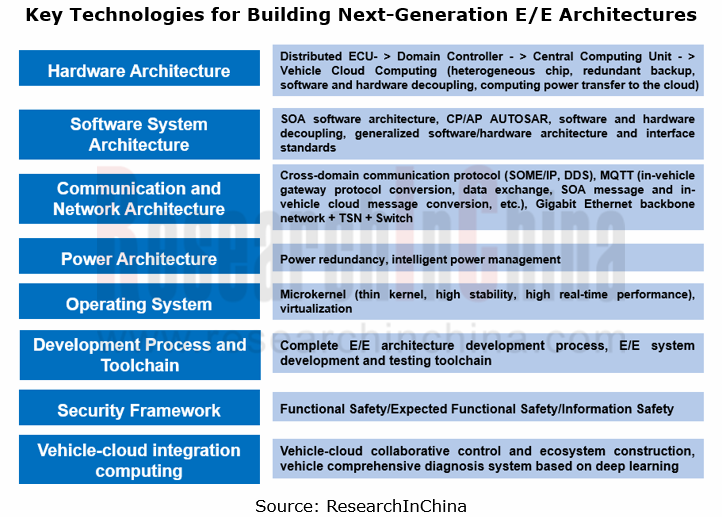
For the development of next-generation E/E architectures, we have summarized 14 key technologies. The following lists and analyzes the progress in some key technologies:
Key technologies of EEA: complete development tool chain, advanced architecture standards, and V-model-based EEA development process.
Currently there is no global automotive EEA standard. ISO 26262 Road Vehicles-Functional Safety, ISO/SAE 21434 Road Vehicles-Cybersecurity Engineering, and GB/T 34590 Road Vehicles-Functional Safety among others provide a reference for design and optimization of automotive EEAs.
In China, in April 2021 Automotive Electronic and Electrical Architecture Working Group was reviewed and established at the second council of the third session of China Industry Technology Innovation Strategic Alliance for Electric Vehicle. At present, experts from over 35 companies including OEMs, architecture solution providers, software firms, communication companies, and testing tools and services providers have participated.
In China, the formulation of automotive EEA standards forges ahead very rapidly. There have been several group or organization standards filed or released, including:
?Data Distribution Service (DDS) Test Methods for Intelligent Connected Vehicles
?Technical Requirements for Security of Automotive Ethernet Switch Equipment
?Technical Requirements for Vehicle Time Sensitive Network Middleware
?Software-Defined Vehicle Service API Reference Specification 2.0
?11 Group Standards in SparkLink Release 1.0
?Technical Requirements and Test Methods for Vehicle Dedicated Short-distance Wireless Transmission System
Key technologies of EEA: computing power tends to be centralized and cluster in cloud, enabling vehicle-cloud architecture integration.
Vehicles are heading in the direction of brain-inspired intelligence + central nerves + terminal nerves. At present, semiconductor vendors inside and outside China are developing and designing vehicle computing center chips with strong computing power for intelligent vehicles. These chips use multi-core parallel CPUs, GPUs for graphics and image processing, and AI computing accelerators. A typical example is NVIDIA ORIN which boasts multi-task parallel computing capabilities for powering cockpits, autonomous driving, AI and more.
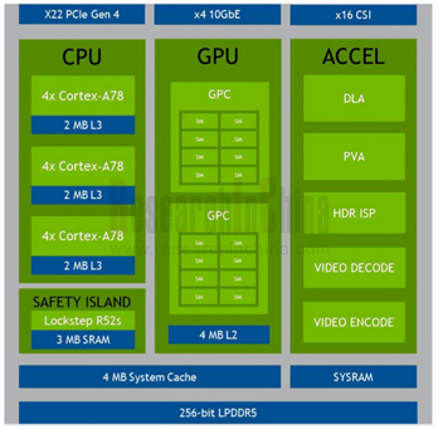
In the future, as vehicle high-speed network and 5G technologies mature, vehicles will eventually tend to be based on central computers and centralized EEA, and evolve towards cooperative vehicle-cloud control; and computing power will be centralized and cluster in cloud to avoid the unlimited expansion of computing power of vehicle terminals.
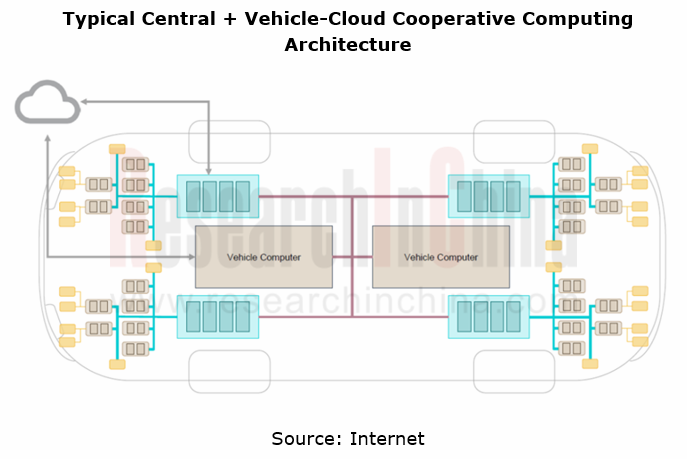
Key technologies of EEA: CP+AP AUTOSAR, SOA software, generalized software/hardware architecture and interface standards.
Vehicle software architectures evolve towards CP+AP AUTOSAR hybrid software architecture. CP AUTOSAR is oriented to the vehicle control domain that requires high reliability and high real-time performance. AP AUTOSAR targets intelligent driving and entertainment domains that need parallel processing of massive data. It also allows standardized design according to functional characteristics of interfaces, and integrates interface designs to build a general interface platform.
With SOA software, automakers enable open ecosystems for development of application services (interfaces are open to the outside), differentiation of scene function development (combination and splicing of any sub-service), and rapid iteration of single scene-based functions (only requiring the reconfiguration of sub-services). In the X-EEA 3.0 architecture of Xpeng Motors, SOA software is primarily applied to cockpit platforms.
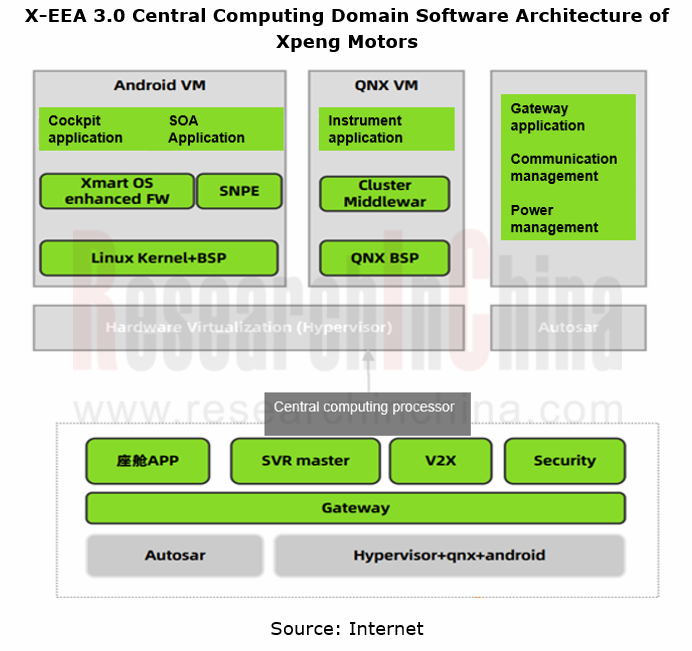
Key technologies of EEA: cross-domain communication protocols (SOME/IP and DDS), Gigabit Ethernet backbone network + TSN + Switch, and high-bandwidth/high-speed communication network, combine to achieve inter-domain high-speed communication and cooperative computing.
Body networks need to meet the performance requirements for the sheer volume of data, high-speed transmission, low latency and high real-time performance. Backbone networks have been Ethernet + CAN-FD high-speed networks, providing the foundation for the cross-domain communication protocol SOME/IP + DDS. The mainstream communication middleware SOME/IP and DDS have their own advantages.
As well as communication middleware, vehicle cloud platforms currently prefer to use MQTT, a communication protocol that allows devices to easily and flexibly connect to IoT cloud services, such as real-time online vehicle data analysis and monitoring, OTA, HD map applications, vehicle big data, and Al analysis.

Key technologies of EEA: vehicle dedicated short-range wireless communication.
In China, SparkLink Alliance was founded in September 2020. Following the launch of SparkLink Release 1.0 in late 2021, the Alliance introduced test instruments and also started the filing of SparkLink Release 2.0 2022H1. Several chip members in the organization have created specific chip-based road signs and plan to launch commercial chips in 2022H2. Based on commercial chips, bellwethers in major industries have formulated development plans for commercial terminals which are projected to come out in 2023.
“SparkLink” short-range wireless communication technology is often used in: immersive vehicle sound zone and noise reduction, wireless interactive mirroring, in-vehicle wireless ambient lighting, 360-degree panoramic surround view, and wireless BMS (battery management system).
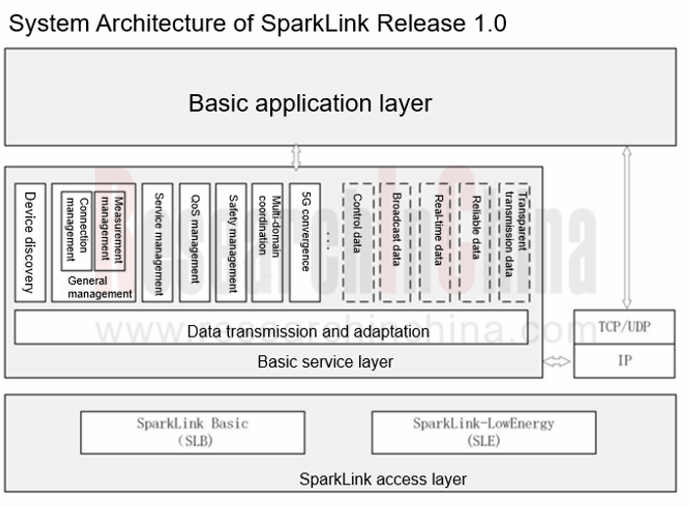
Cadillac LYRIQ is the world’s first one to introduce the wireless battery management system (wBMS), a disruptive technology which reduces 90% battery pack wiring harnesses, and corresponding connectors and plug-ins, fundamentally avoiding the problem of wiring harness aging. Meanwhile, the internal space saved by fewer battery pack wiring harnesses enables more flexible layout and configuration and accommodates more chips to increase the cruising range.
Cadillac uses the wireless battery management system (wBMS) solutions from Analog Devices, Inc. (ADI).
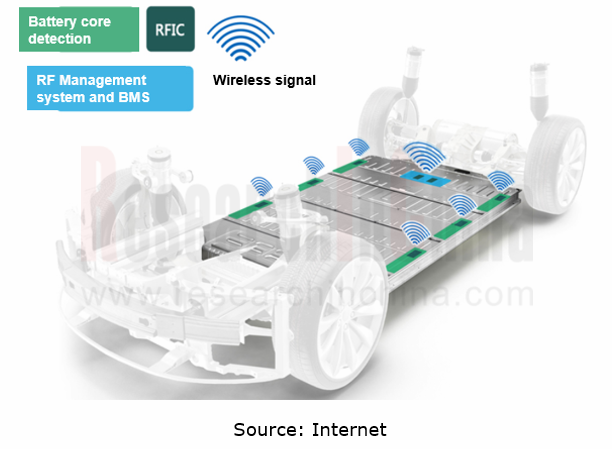
OEMs are stepping up their pace of evolving EEA
- Stage 1: domain centralized architecture
Such architectures as Volkswagen E3, Great Wall Motor’s GEEP3.0 Architecture, BYD's E Platform 3.0, Geely's Sustainable Experience Architecture (SEA) and Xpeng's EE 2.0 are all typical domain centralized architectures.
In Volkswagen E3’s case, this architecture is composed of three domain controllers: vehicle control (ICAS1), intelligent driving (ICAS2), and intelligent cockpit (ICAS3). ICAS1 and ICAS3 have been developed and mounted on models like ID.3 and ID.4, while ICAS2 has not been developed yet. The driving assistance functions are currently called via distributed ECUs and ICAS1.
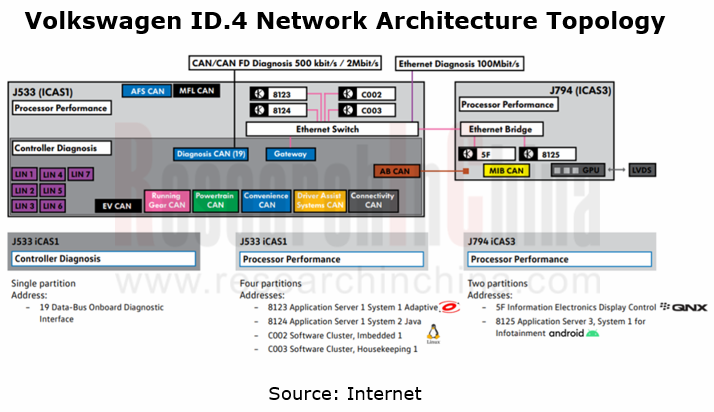
The MEB architecture passes through two stages: E3 1.1 and E3 1.2. The platform offers continuously evolving and optimized functions. Starting from 2025, all the three automakers Volkswagen, Audi and Porsche will use the E3 2.0 SSP (Scalable Systems Platform), a central computing platform which may be first available to the Audi Artemis project.
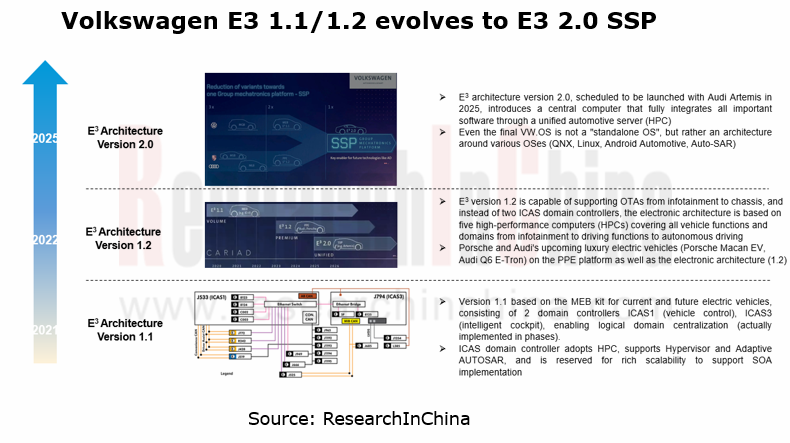
- Stage 2: quasi-central computing architecture, to enable multi-domain integration (e.g., cockpit and driving integration).
Z-ONE’s E/E architecture Galaxy Full Stack 3.0 uses two master-slave high-performance computing units, namely, HPC1 and HPC2, to enable the capabilities of intelligent driving, intelligent cockpit, intelligent computing, and intelligent driving backup, and plus 4 zone controllers, realizes related functions in each zone to fully support L4+ intelligent driving technologies. The architecture will integrate different network communication technologies like CAN FD, Gigabit Ethernet, and 5G, ensuring that a vehicle has powerful enough brain pathways.
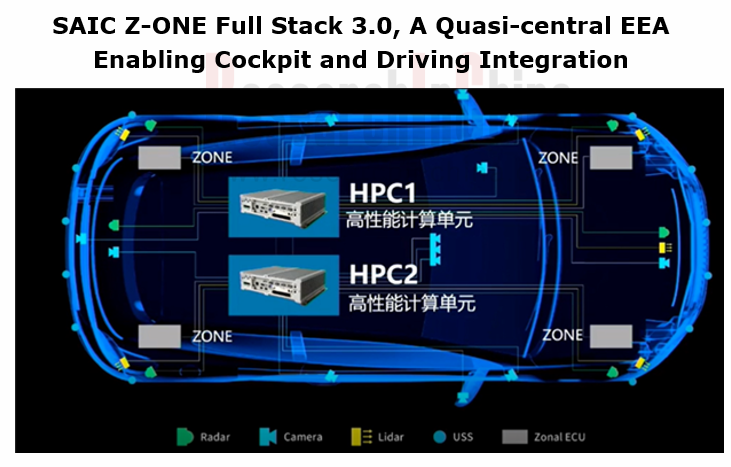
- Stage 3: central computing architecture, with computing power centralized in a supercomputing platform, and the pace of mass production possibly faster than expected.
The framework of the central computing architecture consists of a central computing unit, zone controllers and high-speed Ethernet. The cooperation of the three builds an adaptive and self-learning system to realize intelligent connectivity and high-level autonomous driving.
NIO's central computing unit boasts computing power of more than 1000TOPS, and over 1GHz master frequency. It may use NVIDIA Adam supercomputing platform;
NIO's zone controllers highlight the following functions: distributed edge computing, vehicle control arbitration center, information communication network for SOA service communication, zonal centralized data center, vehicle power distribution hub, and sensor and actuator data exchange. Considering the limited computing resources in zone controllers, NIO uses AMP multi-core architecture in zone controllers for integration and isolation of cross-domain functions, and the RTOS in the AMP mode runs one operating system case on each CPU.
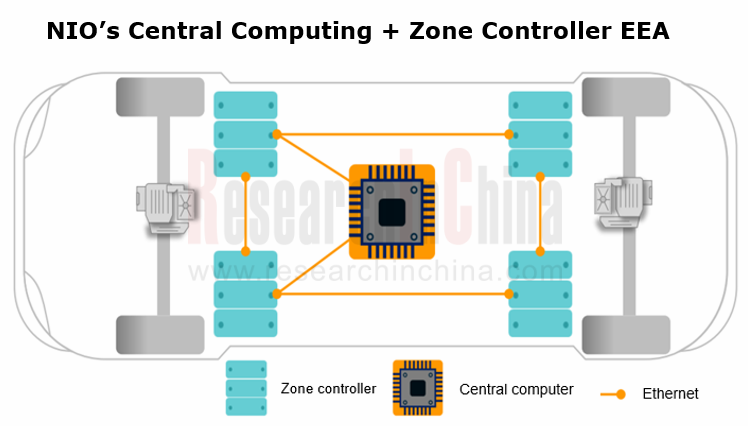
Through the lens of development trends, automotive EEA will eventually evolve to central computing architectures with functional logics centralized in one central controller. OEMs become ever more radical in EEA planning. For emerging carmakers and conventional OEMs, the year of 2023 will be a key time node to mass-produce the next-generation “central computing + zone controller” architectures.
Moreover, as computing platforms with ultra-high computing power are production-ready and software technology iterates rapidly, central computing architectures may even be spawned in the five years to come at the earliest.
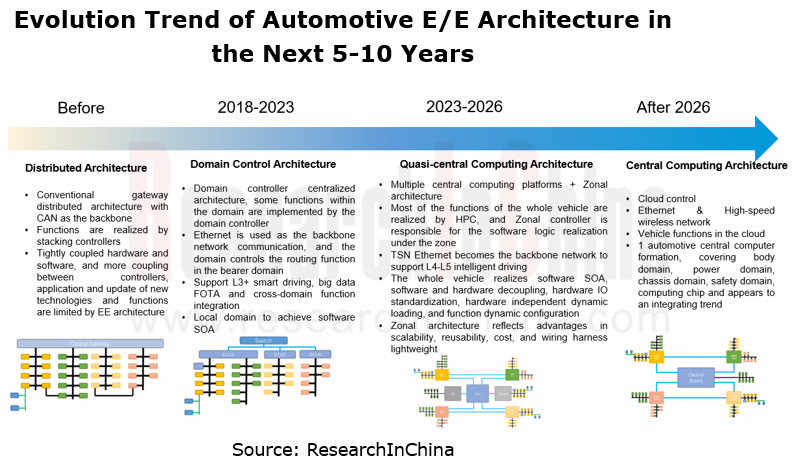
OEMs and Tier 1 Suppliers' Cost Reduction and Efficiency Enhancement Strategy Analysis Report, 2025
ResearchInChina released the "OEMs and Tier 1 Suppliers' Cost Reduction and Efficiency Enhancement Strategy Analysis Report, 2025", summarizing hundreds of cost reduction strategies to provide referen...
Automotive Fixed Panoramic Sunroof and Smart Roof Research Report, 2025
With the intelligent application of car roofs as the core, this report systematically sorts out a series of new products such as fixed panoramic sunroof/openable sunroof, ceiling screen, roof ambient ...
Automotive-Grade Power Semiconductor and Module (SiC, GaN) Industry Research Report, 2025
SiC/GaN Research: Sales volume of 800V+ architecture-based vehicles will increase more than 10 times, and hybrid carbon (SiC+IGBT) power modules are rapidly being deployed in vehicles.
Sales volume o...
Cockpit Agent Engineering Research Report, 2025
Cockpit Agent Engineering Research: Breakthrough from Digital AI to Physical AI
Cockpit Agent Engineering Research Report, 2025 starts with the status quo of cockpit agents, summarizes the technical ...
Prospective Study on L3 Intelligent Driving Technology of OEMs and Tier 1 Suppliers, 2025
L3 Research: The Window of Opportunity Has Arrived - Eight Trends in L3 Layout of OEMs and Tier 1 Suppliers
Through in-depth research on 15 OEMs (including 8 Chinese and 7 foreign OEMs) and 9 Tier 1 ...
China Commercial Vehicle IoV and Intelligent Cockpit Industry Research Report 2025
Commercial Vehicle IoV and Cockpit Research: The Third Wave of Passenger Car/Commercial Vehicle Technology Integration Arrives, and T-Box Integrates e-Call and 15.6-inch for Vehicles
I. The third wav...
Intelligent Vehicle Electronic and Electrical Architecture (EEA) and Technology Supply Chain Construction Strategy Research Report, 2025
E/E Architecture Research: 24 OEMs Deploy Innovative Products from Platform Architectures to Technical Selling Points
According to statistics from ResearchInChina, 802,000 passenger cars with domain...
Research Report on Intelligent Vehicle Cross-Domain Integration Strategies and Innovative Function Scenarios, 2025
Cross-Domain Integration Strategy Research: Automakers' Competition Extends to Cross-Domain Innovative Function Scenarios such as Cockpit-Driving, Powertrain, and Chassis
Cross-domain integration of ...
China Autonomous Driving Data Closed Loop Research Report, 2025
Data Closed-Loop Research: Synthetic Data Accounts for Over 50%, Full-process Automated Toolchain Gradually Implemented
Key Points:From 2023 to 2025, the proportion of synthetic data increased from 2...
Automotive Glass and Smart Glass Research Report, 2025
Automotive Glass Report: Dimmable Glass Offers Active Mode, Penetration Rate Expected to Reach 10% by 2030
ResearchInChina releases the Automotive Glass and Smart Glass Research Report, 2025. This r...
Passenger Car Brake-by-Wire (BBW) Research Report, 2025
Brake-by-Wire: EHB to Be Installed in 12 Million Vehicles in 2025
1. EHB Have Been Installed in over 10 Million Vehicles, A Figure to Hit 12 Million in 2025.
In 2024, the brake-by-wire, Electro-Hydr...
Autonomous Driving Domain Controller and Central Computing Unit (CCU) Industry Report, 2025
Research on Autonomous Driving Domain Controllers: Monthly Penetration Rate Exceeded 30% for the First Time, and 700T+ Ultrahigh-compute Domain Controller Products Are Rapidly Installed in Vehicles
L...
China Automotive Lighting and Ambient Lighting System Research Report, 2025
Automotive Lighting System Research: In 2025H1, Autonomous Driving System (ADS) Marker Lamps Saw an 11-Fold Year-on-Year Growth and the Installation Rate of Automotive LED Lighting Approached 90...
Ecological Domain and Automotive Hardware Expansion Research Report, 2025
ResearchInChina has released the Ecological Domain and Automotive Hardware Expansion Research Report, 2025, which delves into the application of various automotive extended hardware, supplier ecologic...
Automotive Seating Innovation Technology Trend Research Report, 2025
Automotive Seating Research: With Popularization of Comfort Functions, How to Properly "Stack Functions" for Seating?
This report studies the status quo of seating technologies and functions in aspe...
Research Report on Chinese Suppliers’ Overseas Layout of Intelligent Driving, 2025
Research on Overseas Layout of Intelligent Driving: There Are Multiple Challenges in Overseas Layout, and Light-Asset Cooperation with Foreign Suppliers Emerges as the Optimal Solution at Present
20...
High-Voltage Power Supply in New Energy Vehicle (BMS, BDU, Relay, Integrated Battery Box) Research Report, 2025
The high-voltage power supply system is a core component of new energy vehicles. The battery pack serves as the central energy source, with the capacity of power battery affecting the vehicle's range,...
Automotive Radio Frequency System-on-Chip (RF SoC) and Module Research Report, 2025
Automotive RF SoC Research: The Pace of Introducing "Nerve Endings" such as UWB, NTN Satellite Communication, NearLink, and WIFI into Intelligent Vehicles Quickens
RF SoC (Radio Frequency Syst...